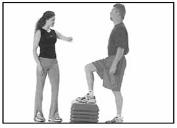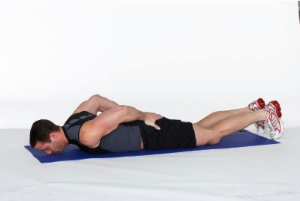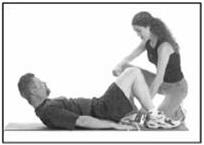The Exam Process
There are 3 components to your pre-hire evaluation. This is what you can expect when you arrive for your exam.
1) The Receptionist or Medical Assistant will ask you to sign several forms which may include a privacy act statement, a consent for the agility/musculoskeletal testing, and an OF 178 (details the physical requirements of the position), and your medical history form(s). Then the Medical Assistant will perform the following tests:
• Vital signs (blood pressure, pulse, respirations, temperature, height, and weight)
• Vision screening (near, far, color, depth, and peripheral vision)
• Hearing test
• Urinalysis (NOTE: This is NOT for drug testing. Drug testing, if required, is done by a separate entity and the clinic is not involved in that process)
Other special tests may be performed depending on the position requirements or if medically indicated, including:
• Electrocardiogram (Police, Fire, Deployable - or if indicated)
• Pulmonary Function Test (Police, Fire, Deployable and Respirator users - or if indicated)
• Blood work (Police, Fire, and Deployable - or if indicated)
• TB skin test (Fire, cafeteria, childcare, and Deployables only)
• Vision screening (near, far, color, depth, and peripheral vision)
• Hearing test
• Urinalysis (NOTE: This is NOT for drug testing. Drug testing, if required, is done by a separate entity and the clinic is not involved in that process)
Other special tests may be performed depending on the position requirements or if medically indicated, including:
• Electrocardiogram (Police, Fire, Deployable - or if indicated)
• Pulmonary Function Test (Police, Fire, Deployable and Respirator users - or if indicated)
• Blood work (Police, Fire, and Deployable - or if indicated)
• TB skin test (Fire, cafeteria, childcare, and Deployables only)
2) The Clinician will review the medical history and test results and perform a hands-on physical exam of:
• Eyes, ears, nose, throat • Heart and circulation • Lungs • Abdomen • Neck and back • Arms, legs, and all joints • Balance and neurological evaluation • Hernia check (males only)
NOTE: Your exam will not include a rectal, pelvic, or breast exam.
NOTE: Your exam will not include a rectal, pelvic, or breast exam.
3) A Clinic Assistant will administer an Agility Test/Musculoskeletal Evaluation*
*Unless the Clinician has determined the Agility Test/Musculoskeletal Evaluation is unsafe or contraindicated.
*Unless the Clinician has determined the Agility Test/Musculoskeletal Evaluation is unsafe or contraindicated.
The Agility Test/Musculoskeletal Evaluation
A: There are 3 main parts of the basic Agility Test/Musculoskeletal Evaluation
1) Step Test
This is a test to measure cardiovascular endurance as well as strength and range of motion of the legs, hips, knees, and ankles.

Individuals 5' 4" or taller will use a 14" step.
A metronome is used to set a pace of 25 steps per minute for individuals under 40 yrs of age and 24 steps per minute for individuals 40 years of age or older.
The applicant steps up and down at the pre-determined pace for 3 minutes. At the end of 3 minutes the applicant sits down and their heart rate is measured. Then the applicant is asked to remain seated and rest for 1 minute and the heart rate is measured again. This determines the recovery heart rate which is a standardized method of evaluating cardiovascular health.
2) Floor exercises
These tests assess
• how well the back and abdominal muscles work together
• muscular endurance for lifting, pulling, twisting, etc.
• strength, range of motion, flexibility of upper back, shoulders, elbows, and wrists
NOTE: There is not a minimum number required as all components of the test are used in combination to determine evaluation outcome.
• how well the back and abdominal muscles work together
• muscular endurance for lifting, pulling, twisting, etc.
• strength, range of motion, flexibility of upper back, shoulders, elbows, and wrists
NOTE: There is not a minimum number required as all components of the test are used in combination to determine evaluation outcome.
Back Extensions
Lie flat on belly with arms down at sides, palms facing up
Keeping neck in a neutral position, lift the upper body off the mat and then return to the flat position. Perform as many of these as possible in 1 minute.
Lie flat on belly with arms down at sides, palms facing up
Keeping neck in a neutral position, lift the upper body off the mat and then return to the flat position. Perform as many of these as possible in 1 minute.



Lie on back with knees bent and arms at sides flat on the floor. Lift the upper body to approximately 45 degrees (a measurement is done to help with this) and return to the mat. Perform as many of these as possible in 1 minute.

To start - lie flat on belly with hands flat on ground approximately shoulder-width apart. Applicant may do these on the knees or the toes or may switch at any time*. As long as the back remains straight - do not sway the back and do not stick the buttocks up in the air.
Push up with arms to fully extended position (without locking elbows) and then lower down to elbows at a 90 angle to the floor. Perform as many of these as possible in 1 minute.
* Police and Fire are required to do these on the toes. Additionally, Police and Fire have additional testing. See FAQ section.
3) Lifting assessment and repetitive lift/carry

This gives an opportunity to assess lifting ability and provide guidance on proper lifting technique. The amount you are required to lift will depend on the position description for the job you are applying for.
• You will be asked to demonstrate lifting an empty bin from floor level.
• Once you have demonstrated good technique, weight will be incrementally added to the amount required for the position.
• You will then be asked to lift and carry the maximum weight approximately 10 feet. Put the bin down on a shelf, lift it back up, turn around, carry the bin back to the original location and put it back down on the floor. You will do 10 repetitions of this exercise.
• Lastly, you will be asked to lift 10 pounds over shoulder height for 10 repititions
NOTE: The Clinic Assistant may stop you at any time during the testing if your lifting technique is unsafe.
• You will be asked to demonstrate lifting an empty bin from floor level.
• Once you have demonstrated good technique, weight will be incrementally added to the amount required for the position.
• You will then be asked to lift and carry the maximum weight approximately 10 feet. Put the bin down on a shelf, lift it back up, turn around, carry the bin back to the original location and put it back down on the floor. You will do 10 repetitions of this exercise.
• Lastly, you will be asked to lift 10 pounds over shoulder height for 10 repititions
NOTE: The Clinic Assistant may stop you at any time during the testing if your lifting technique is unsafe.

